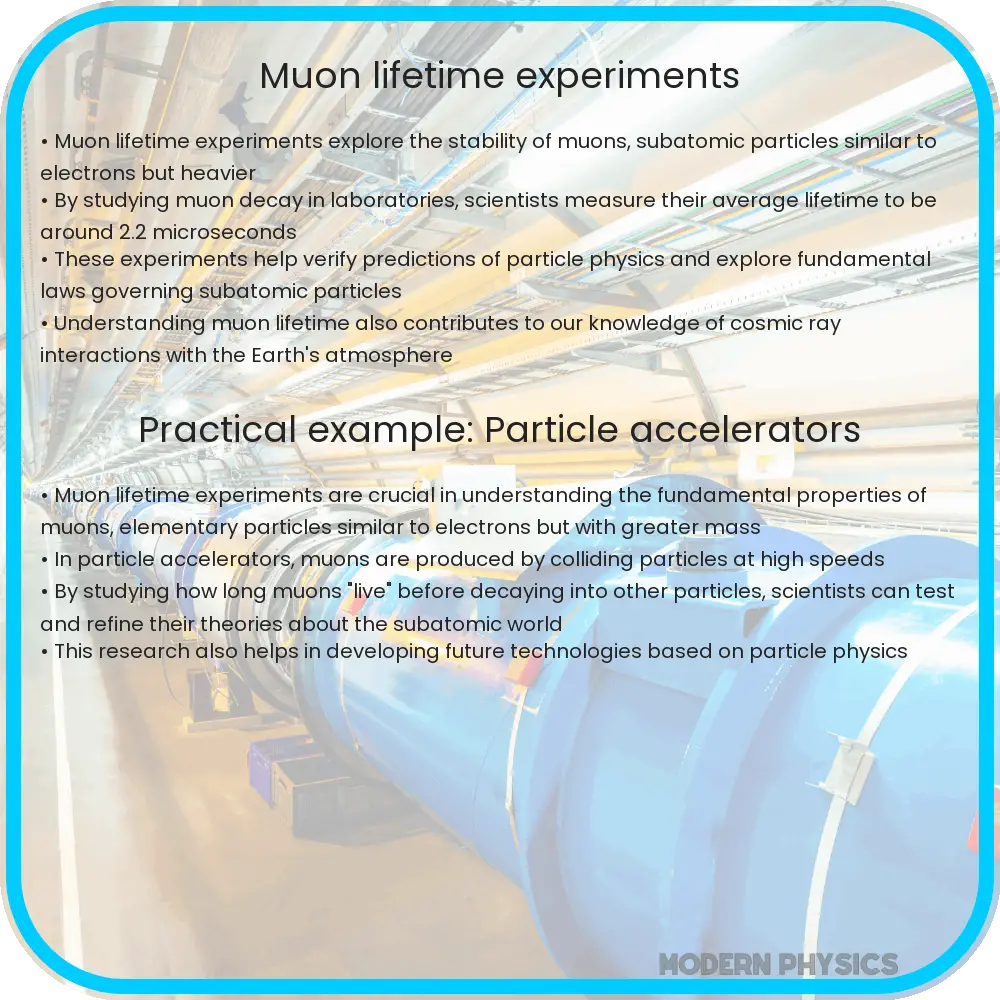Explore the precision and impact of muon lifetime experiments in particle physics, and their role in advancing our understanding of the universe.

Muon Lifetime Experiments: Unraveling the Mysteries of Fundamental Particles
The study of muon lifetime is a cornerstone of modern particle physics, offering critical insights into the fundamental principles that govern our universe. Muons are subatomic particles similar to electrons, but with a greater mass. They are unstable, decaying into electrons and neutrinos with a mean lifetime of around 2.2 microseconds. This seemingly brief existence provides a window into the intricate world of particle interactions and the forces that shape our physical reality.
Precision in Measurement: The Key to Understanding Muon Decay
To comprehend the significance of muon lifetime experiments, one must first appreciate the precision required in these measurements. Given the muon’s rapid decay, experiments must be extraordinarily precise. Advanced detectors and timing equipment are utilized to measure the time between a muon’s creation and its decay. The precision of these experiments is not just a technical challenge; it directly impacts our understanding of fundamental physics. For instance, slight variations in measured lifetimes can indicate new physics beyond the Standard Model, such as supersymmetry or hidden-sector particles.
The Impact of Muon Lifetime on Theoretical Physics
Muon lifetime experiments have profound implications for theoretical physics. These experiments test the validity of the Standard Model, the current best theory describing the fundamental particles and forces, excluding gravity. In particular, the muon’s decay involves weak interactions, one of the four fundamental forces. Precise measurements of the muon’s lifetime help refine our understanding of these interactions and their role in the universe’s evolution.
Experimental Approaches and Challenges
There are several methods to measure muon lifetime. One common approach is the use of “muon stoppers,” materials in which muons are slowed and captured. Detectors surrounding these materials then record the decay products of the muons. Another method involves particle accelerators, where muons are generated and their decay observed in flight. Each method has unique challenges, such as controlling environmental factors that could affect measurements or dealing with background radiation.
The precision of these experiments is influenced by various factors, including the purity of the muon sample, the efficiency of the detectors, and the accuracy of the timing mechanisms. Advances in technology and experimental techniques continue to enhance the precision of muon lifetime measurements, thus pushing the boundaries of our understanding of fundamental physics.
Advancements in Technology and Their Role in Muon Experiments
Technological advancements play a pivotal role in enhancing the precision of muon lifetime experiments. Developments in digital electronics, for instance, have led to more accurate timing systems, crucial for measuring the muon’s brief existence. Similarly, improvements in detector technology, such as scintillators and gas detectors, have increased the efficiency of capturing muon decay events. These technological innovations not only improve the accuracy of current experiments but also open avenues for new experimental designs that could unveil previously inaccessible aspects of particle physics.
Understanding the Universe: Theoretical Implications
The study of muon lifetime extends beyond the realm of particle physics, offering insights into cosmology and astrophysics. For example, understanding muon decay is essential for interpreting cosmic ray showers and the high-energy processes occurring in the universe. Additionally, discrepancies between experimental results and theoretical predictions can suggest the existence of new particles or forces, potentially leading to groundbreaking discoveries about the universe’s composition and origin.
Collaborations and Future Prospects
Global collaborations are integral to muon lifetime research. Large-scale experiments often involve scientists from various countries, pooling resources and expertise. Such collaborations not only advance the field but also foster a spirit of international cooperation in scientific inquiry. Looking ahead, the future of muon lifetime experiments is promising, with plans for more sophisticated detectors and accelerators that could unravel new physics and deepen our understanding of the universe.
Conclusion
In summary, the study of muon lifetime is a vital aspect of particle physics, offering profound insights into the fundamental forces and particles that constitute our universe. The precision of these experiments, driven by technological advancements and international collaborations, challenges and refines our theoretical understanding of physics. As we continue to probe the mysteries of muon decay, we edge closer to unraveling the complexities of the universe, potentially paving the way for revolutionary discoveries in physics and cosmology.
